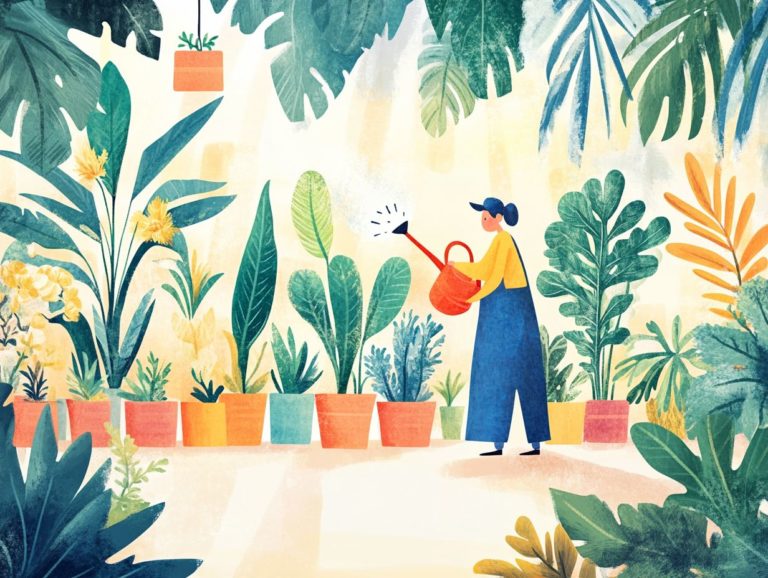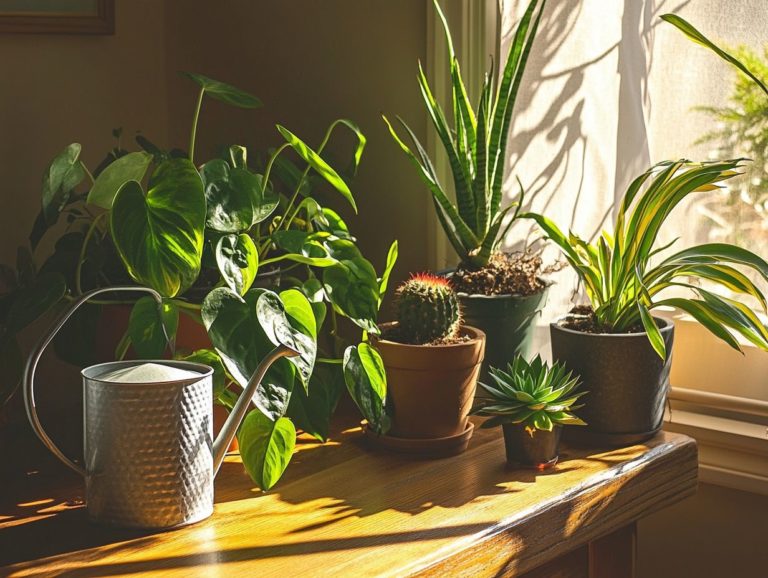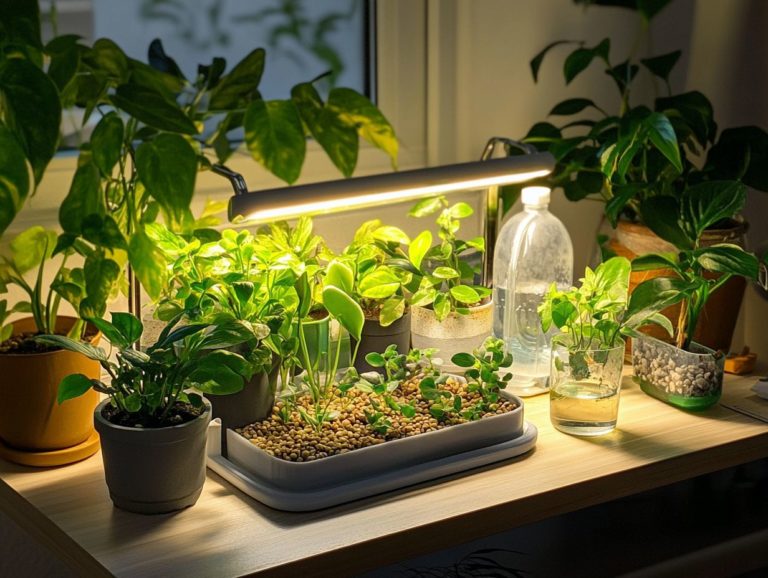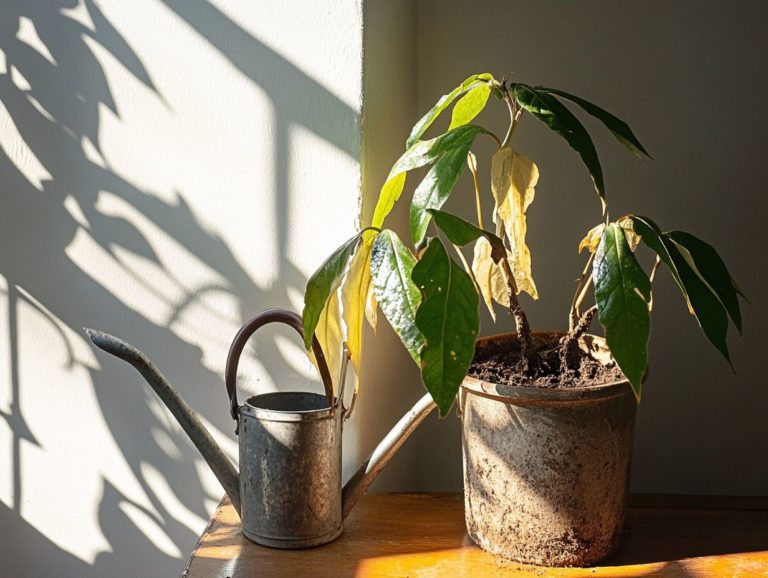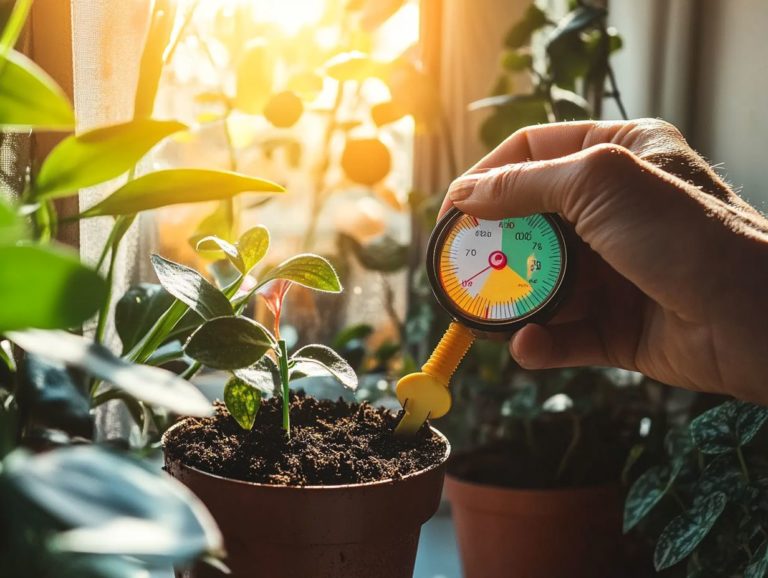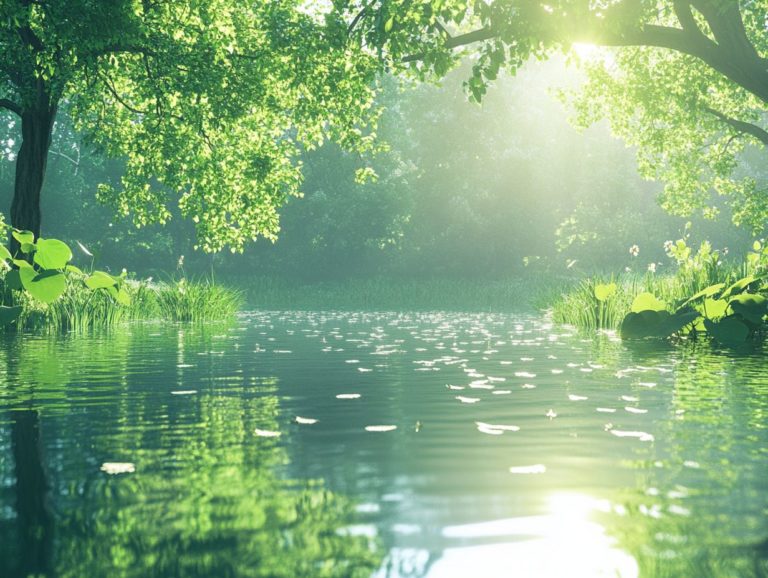Indoor Plants that Thrive with Minimal Water
Are you eager to infuse your home with a touch of greenery without the burden of frequent watering? Low water indoor plants offer fantastic benefits that anyone can enjoy, marrying aesthetics with effortless maintenance.
From hardy succulents to eye-catching cacti, these plants thrive with minimal care while elevating your living environment.
Discover your ideal low-water plants today! You’ll find an array of low-water plants, essential care strategies, and practical tips for troubleshooting common challenges, ensuring your indoor garden thrives with ease.
Contents
Key Takeaways:
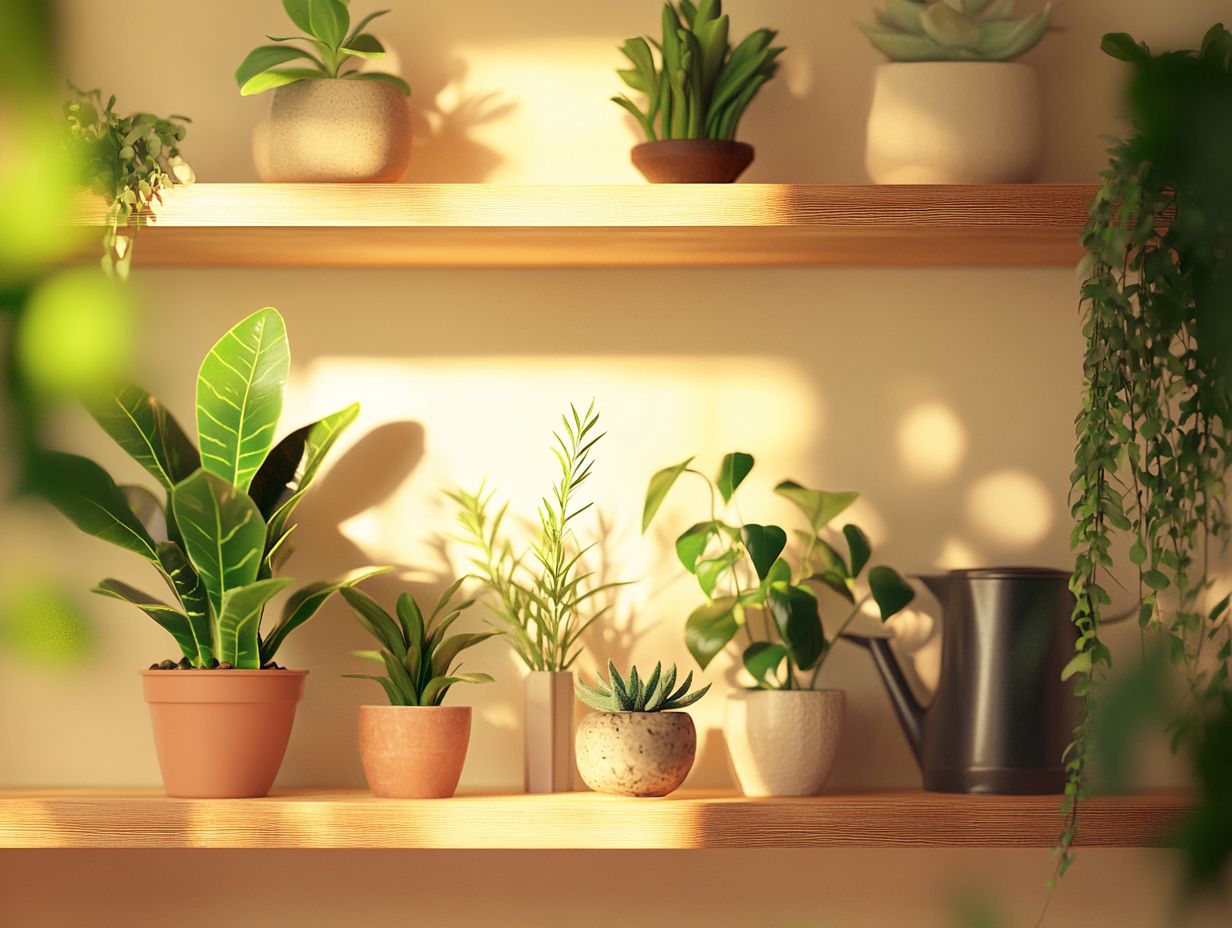
- Choose low water plants like succulents, cacti, and aloe vera to save time and money on watering while still enjoying the benefits of indoor plants.
- Proper care for low water plants includes watering techniques that allow the soil to dry out between waterings and providing adequate light and temperature.
- Common issues with low water plants can be avoided by monitoring watering frequency and adjusting light and temperature as needed.
Benefits of Low Water Plants
Low water indoor plants present numerous advantages, making them the perfect choice for both novice and seasoned plant lovers. These resilient species, including Ficus Elastica, Sansevieria, and Echeveria, flourish with minimal care while enhancing your indoor air quality.
By understanding how plants grow like photosynthesis, the process plants use to make food from sunlight you can ensure optimal health for your plants, regardless of seasonal changes. These low water needs cater to your busy lifestyle, allowing you to cultivate a lush, green environment without the anxiety of a demanding care routine.
Types of Low Water Indoor Plants
Exploring the world of low-water indoor plants unveils a diverse selection of species that can flourish in various home environments while thriving on minimal watering. You ll find popular choices like the Snake Plant and the Chinese Money Plant, both celebrated for their resilience and low water needs.
These plants not only elevate your space with their striking foliage but also engage in essential biological processes, such as transpiration and photosynthesis, to maintain their health. The categories of low-water plants include Succulents, Cacti, and other drought-resistant varieties, each uniquely adapted to conserve moisture and thrive indoors.
Succulents
Succulents, like Echeveria and Lithops, are celebrated for their remarkable ability to store water in their leaves, making them perfect for your low-water indoor garden. These plants are designed to grow easily with little care, appealing to both novices and seasoned plant enthusiasts.
With a stunning array of shapes and colors, these plants can elevate any home d cor. When you care for them properly paying attention to soil composition and sunlight exposure succulents can flourish for years, striking a harmonious balance between beauty and ecological efficiency.
Take Echeveria, for example. This succulent thrives in well-draining soil and bright, indirect light, ensuring it retains its vibrant colors without becoming leggy. Then there s Lithops, affectionately known as ‘living stones.’ These fascinating plants thrive in sandy, gritty soil and require even less water, often needing a good soak only a handful of times each year. Both varieties naturally adapt to arid environments, showcasing incredible resilience.
To keep them in peak condition, establish a consistent watering schedule; allowing the soil to dry completely between waterings is crucial in preventing root rot. A sprinkle of balanced fertilizer during the growing season can boost their growth, ensuring these captivating plants remain a stunning focal point in any setting.
Cacti
Cacti exemplify plants that need little water brilliantly adapted to thrive in arid environments, making them an ideal choice for your indoor gardening ventures with their low water needs. These resilient species flourish in direct sunlight and demand a well-draining soil mix to truly shine.
With their diverse shapes and vibrant blooms, cacti infuse a hint of the wild into your interior decor while promoting minimal watering schedules, making them a perfect fit for those busy days when watering might slip your mind. To explore more about the most resilient indoor plants, their impressive ability to store water means they remain healthy, even with intermittent attention.
To appreciate the beauty and robustness of cacti, it s essential to explore the various types, such as the iconic Saguaro, the striking Knight s, and the charming Barrel cacti, each boasting its unique features and care needs. Ideally, these hardy plants thrive in bright and warm environments, but be mindful of their watering requirements; overwatering can damage the roots if the plant gets too much water and undermine their intrinsic drought-resistant qualities.
Adjusting your care routine seasonally, like reducing water during the winter months, plays a crucial role in maintaining their health. Nurturing these captivating specimens invites you to embrace their resilient nature, making it all the more rewarding to cultivate a thriving indoor garden!
Aloe Vera

Aloe Vera is not just a visual delight; it s also a champion of low water needs! This resilient succulent thrives on minimal fuss, needing only occasional watering while effortlessly engaging in vital processes like photosynthesis and nutrient transport. Its gel-filled leaves serve as a natural remedy for various skin issues, adding to its allure beyond just good looks.
When you place it in bright, indirect light and well-draining soil, Aloe Vera can truly thrive, bringing both beauty and practicality into your space.
To ensure your Aloe reaches its full potential, remember to water it sparingly. Allow the soil to dry out completely between waterings to help prevent root rot. This plant prefers sandy or cactus mix soil that encourages drainage, keeping excess moisture at bay, which is crucial for its well-being.
Plus, Aloe Vera s knack for filtering indoor air pollutants enhances your environment, contributing to cleaner, fresher air in your home. Its remarkable ability to absorb toxins through tiny pores in its leaves, combined with its low light requirements, makes this succulent an ideal choice for elevating air quality while adding a stunning focal point to your decor.
Snake Plant
The Snake Plant, with its striking upright leaves and remarkable ability to flourish in low light, stands out as a quintessential low-water plant that s incredibly easy to care for! It’s no wonder it’s a favorite in so many homes.
This hardy plant showcases exceptional adaptability, effortlessly tolerating a range of environmental conditions while infusing any room with a touch of elegance. Its natural resistance to drought makes it an ideal choice for those who might occasionally forget to water regularly.
To keep your Snake Plant in optimal health, remember to let the soil dry out between watering sessions, using a well-draining potting mix to prevent those pesky waterlogged roots. It’s also wise to check the leaves for signs of overwatering, like yellowing or mushiness.
By following these straightforward yet effective care tips, you can easily cultivate a thriving indoor oasis with this resilient beauty! Discover the top indoor plants that thrive in poor soil and start your indoor garden today, enjoying the beauty and ease of these amazing plants!
Pothos
Pothos is an exceptional indoor plant that you’ll quickly come to adore, thanks to its low water requirements and ability to thrive in a variety of lighting conditions. Whether you re a novice or a seasoned plant enthusiast, it makes for an ideal choice.
This attractive vine boasts glossy, heart-shaped leaves that cascade down elegantly, all while exhibiting a remarkable tolerance to neglect. Perfect for indoor environments, Pothos flourishes beautifully in both bright, indirect sunlight and low-light settings, though it truly thrives with a touch of filtered light.
Taking care of this plant is easy and fun! Set a regular watering routine, allowing the top inch of soil to dry out between watering sessions. This helps you avoid the risk of too much water. Watch humidity levels and ensure good drainage. You ll find that Pothos becomes a vibrant addition to any space you choose.
Caring for Low Water Indoor Plants
Caring for low water indoor plants requires a refined understanding of their specific needs, enabling them to thrive with minimal upkeep. Your success in plant care hinges on implementing a simple watering plan for each plant, alongside recognizing their soil and fertilizer requirements to support robust biological processes.
Light and temperature also play a big role in their growth, so seasonal adjustments are essential to optimize their environment. By embracing these practices, you can cultivate a harmonious atmosphere for low water plants like Pothos and Snake Plant, as well as explore the best indoor foliage plants for low light, allowing them to flourish with ease.
Watering Techniques
Effective watering techniques are crucial for maintaining plant health, especially for those low-water species that are sensitive to overwatering. By understanding the specific watering needs of each plant, you can develop a tailored watering schedule that strikes the perfect balance between moisture levels and vitality. Pay attention to the soil moisture and adjust your approach as the seasons change, ensuring your plants thrive in their unique environments.
With the right techniques, you can easily prevent common issues and promote robust growth in your indoor greenery. Consider employing methods such as drip irrigation, which delivers water directly to the roots, or using a moisture meter for real-time insights into soil conditions. If you’re curious about what indoor plants thrive in low light, knowing how plants lose water helps you decide when to water.
For plants that thrive in drier settings, layering gravel or sand can enhance drainage and prevent water buildup. Remember, overwatering can lead to root rot, a common problem that can be easily avoided by allowing the top inch of soil to dry out between waterings.
By adapting your strategy based on climate, pot size, and each plant’s specific needs, such as Ficus Elastica and Sansevieria, you can cultivate a flourishing indoor garden. For tips on what indoor plants are best for low maintenance, that thrive under your care, consider your options carefully.
Light and Temperature Requirements
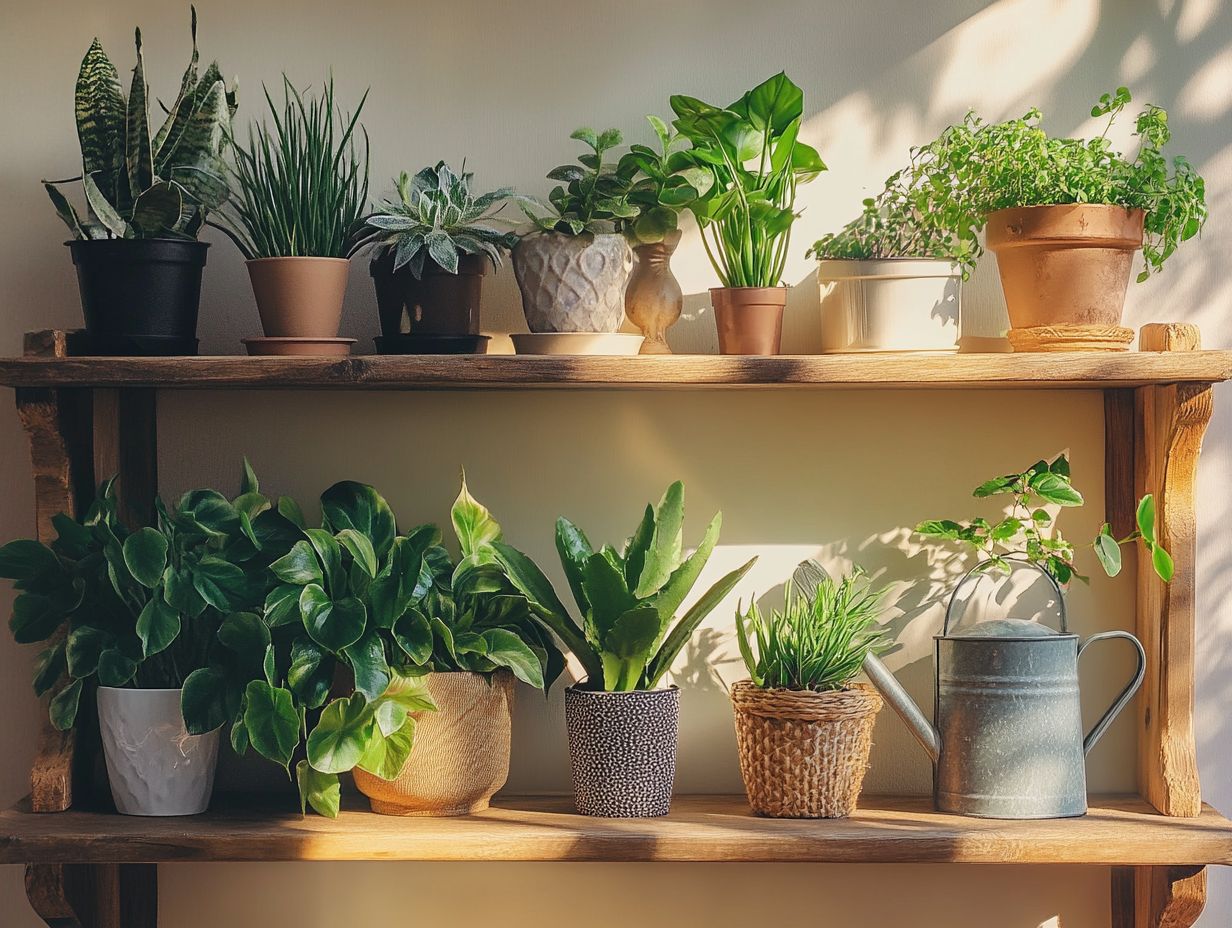
To help your plants thrive, you must know their light and temperature needs. Each species, from the resilient Snake Plant to the vibrant Echeveria, has its own specific light requirements, ranging from low to bright indirect sunlight. These plants can react differently to seasonal changes, so careful observation of their environment is crucial to ensure they thrive throughout the year.
To create that ideal environment, monitor the intensity and duration of light exposure, especially during those shorter winter days when supplemental lighting could be a game changer. Many low-water plants thrive best in temperatures between 65 F and 80 F. Avoiding drastic fluctuations in temperature is key to their growth. During the warmer months, you might want to position them in slightly shadier spots to shield them from harsh, direct sunlight that can lead to leaf burn.
By observing how each plant reacts to its surroundings, you ll be empowered to make informed decisions regarding plant care and ensure they receive just the right amount of attention. Take a moment to watch how your plants react to different light levels and adjust accordingly!
Soil and Fertilizer Needs
The soil and fertilizer needs of low water plants are pivotal for maintaining their health and vitality. These factors significantly influence their ability to thrive indoors.
Using well-draining soil is a must for your plants success! It helps prevent overwatering and root rot, especially for drought-resistant species like Cacti and Aloe Vera.
Regular soil tests help you identify a lack of essential nutrients. This allows you to make informed decisions about fertilizer application.
By addressing these needs, you can create an optimal growth environment for your low water plants, promoting robust health and longevity.
Understanding the specific soil composition suited for these plants is crucial. It directly impacts their growth patterns and resilience.
The ideal mix usually features components like sand, perlite, or pumice. These enhance drainage while still retaining some organic matter to support vital microorganisms.
Opting for a slow-release fertilizer with a balanced nutrient profile ensures a steady supply of key elements like nitrogen, phosphorus, and potassium. This approach boosts plant health and minimizes the risk of nutrient runoff.
By being proactive and attentive, you can guarantee that your plants receive the necessary care. This leads to flourishing foliage and vibrant blooms. Attention to detail can also prevent overwatering issues.
Troubleshooting Common Issues
Troubleshooting common issues faced by low water indoor plants is essential for maintaining their health and vitality. These plants can be quite sensitive to both overwatering and underwatering.
Many plant owners may unintentionally cause harm by misjudging their watering schedules. This can lead to telltale signs like wilting or yellowing leaves.
Recognizing these early indicators and understanding the need for seasonal adjustments helps you promptly address these concerns. This keeps your indoor greenery vibrant and flourishing.
Implementing effective plant care strategies will significantly enhance your ability to ensure that low water plants thrive beautifully in your home.
Overwatering
Overwatering is a common challenge that can greatly affect your plants health. This is especially true for low-water species that are naturally sensitive to excess moisture in the soil.
These plants thrive in dry environments. Excess moisture can lead to serious health issues when their roots are submerged in overly saturated soil.
You might think that giving them more water is helpful, but it can lead to problems like fungal infections and poor nutrient absorption.
To sidestep these pitfalls, establish a watering routine that respects the unique needs of your plants and the prevailing environmental conditions.
Using moisture meters, which are tools that measure how wet the soil is, or simply checking the top inch of soil can provide valuable insights into when it’s time to water. This ensures that the soil remains in the sweet spot for healthy growth.
With a more informed approach, you can foster the resilience and vitality of these low-water plants, allowing them to truly thrive.
Underwatering
Underwatering can lead to serious consequences for your indoor plants, especially those with low water requirements that aren t fans of prolonged dryness.
If you notice symptoms like drooping leaves, dry soil, or slowed growth, it s a clear sign that your plants aren t getting enough moisture.
Establishing a consistent watering schedule can be a lifesaver, particularly for moments when you might forget to water.
By understanding your plants’ specific needs and recognizing the signs of underwatering, you can keep them healthy and thriving.
As a plant owner, it s crucial to actively observe your greenery. Ignoring these important signals can result in irreversible damage.
Even low-water plants, while more forgiving, can show stunted growth or signs of stress if neglected.
A simple solution is to create a routine that aligns with the specific conditions in your environment. Consider factors like humidity, light exposure, and temperature, as they play key roles in determining how often your plants need watering.
Maintaining open lines of communication with your plants needs enhances your care and deepens your understanding and appreciation for these resilient companions.
Regular awareness of their water needs fosters a stronger connection.
Frequently Asked Questions
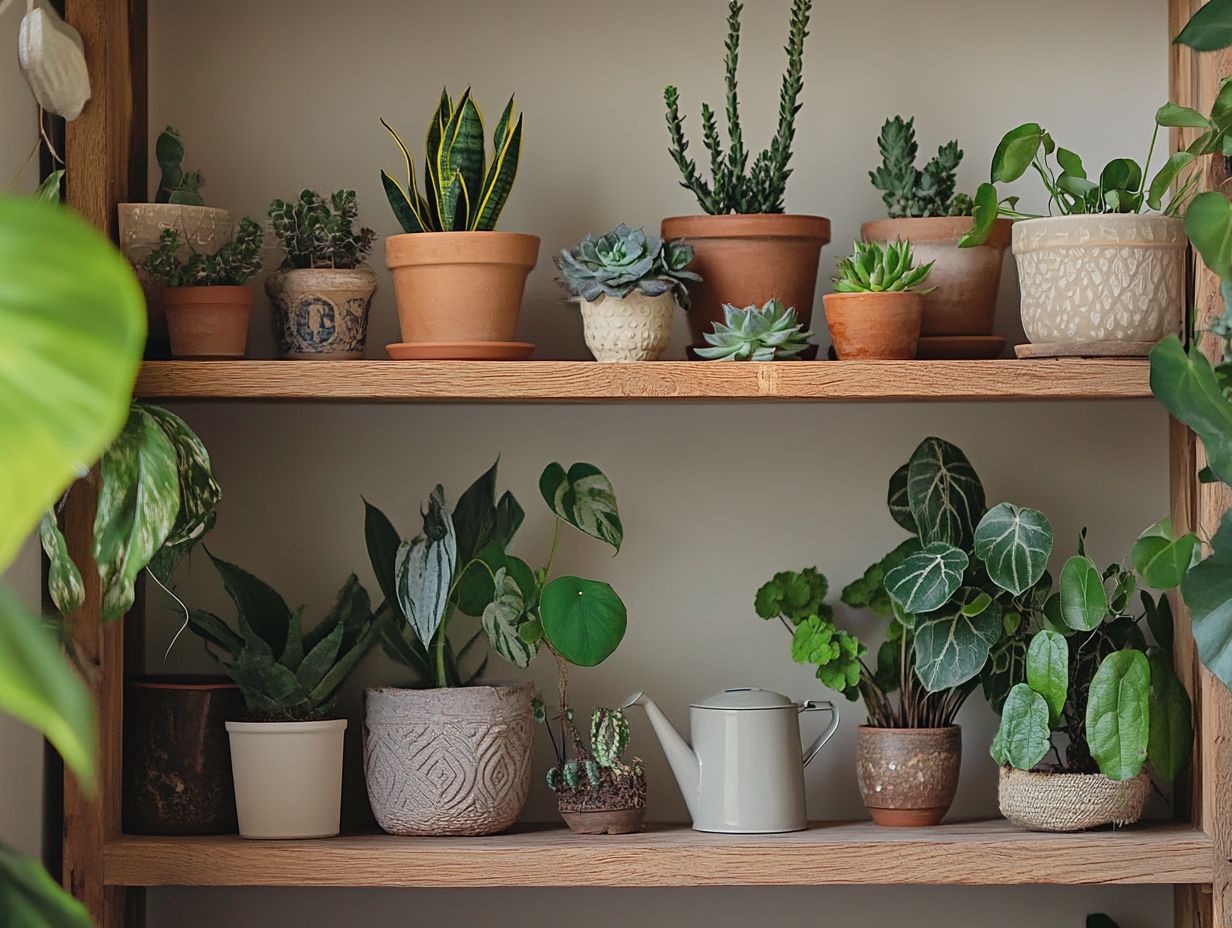
What are some common indoor plants that thrive with minimal water?
Common indoor plants that need little water include succulents, spider plants, and snake plants.
Can I overwater these plants?
Yes, overwatering is a risk. Only give them enough water to keep the soil slightly moist to avoid root problems.
How often should I water my plants?
Watering frequency depends on the plant type, pot size, and light. Generally, these plants do well with weekly watering or when the top inch of soil is dry.
Can I use fertilizer on my plants?
You can use a diluted fertilizer during the growing season. Just follow the package instructions and don t overdo it.
Do these plants need a lot of sunlight?
Most thrive in low to moderate light. However, they still need some natural light for best growth and health.
What signs indicate my plant needs more water?
Look for wilting leaves, yellowing foliage, and dry soil. Always check the soil moisture before watering to prevent overwatering.

